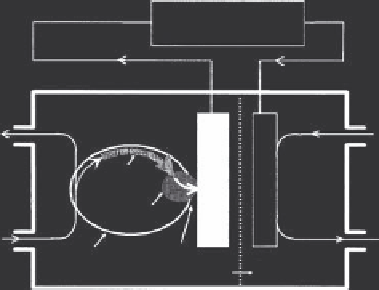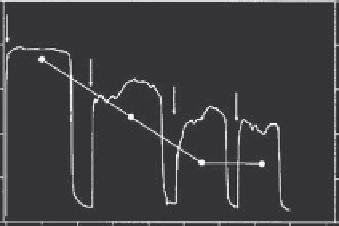Biomedical Engineering Reference
In-Depth Information
(a)
Load
e
-
Oxidized
fuel
Oxidant
Electron
transport
System
OM cytochrome
e
-
Reduced
oxidant
Fuel
Bacterium
Direct electron
transfer
via
Cytochrome
H
+
Ion-exchange membrane
Anode compartment
Cathode compartment
(b)
0.05
10
0.04
8
0.03
6
0.02
4
0.01
2
0.00
0
0123456789
Time (day)
FIGURE 13.5
(a) Schematic diagram of a mediatorless microbial fuel cell, (b) current and
coulombic yield of a cell (apparent electrode surface area: 50 cm
2
) con-
taining
Shewanella putrefaciens
IR-1 (0.2
0.02 g dry cell weight/L) with
a 1 kΩ resistor and intermittent additions of 10 mM lactate (shown by
arrows). (Reprinted from Kim, H.J., Park, H.S., Hyun, M.S., Chang, I.S., Kim,
M., and Kim, B.H.,
Enzyme Micro. Tech.,
30, 2002. With permission from
Elsevier.)
±
and Logan 2004; Willner et al. 2007) as the next generation of power
sources. Such biofuel cells extend the hydrogen fuel cell concept for replac-
ing the expensive inorganic catalyst and fuel with renewable biocatalysts
and fuels; for example, alcohol dehydrogenase for an enzymatic biofuel cell
and alcohol (Akers et al. 2005) or Shewanella-based microbial biofuel cells
(Kim et al. 1999; Ringeisen et al. 2006) with accompanying substrates
(e.g., ethanol or glucose).



Search WWH ::

Custom Search